Deepest Late Bronze Age shipwreck ever discovered in Mediterranean off Israeli coast
Unique shipwreck reveals advanced navigational skills, insights into trade networks

During an exploration of natural gas, a 3,300-year-old ship’s cargo was found some 90 km (56 miles) off the northern coast of Israel, at an extraordinary depth of 1.8 km (about one mile) below the surface, on the floor of the Mediterranean Sea.
This shipwreck, dated to the Late Bronze Age, or the Late Canaanite period in Israel, is the oldest ever found in deep seas and provides unprecedented evidence of the navigational skills of ancient seamen.

"This find reveals to us as never before the ancient mariners’ navigational skills – capable of traversing the Mediterranean Sea without a line of sight to any coast," says Jacob Sharvit, Head of the Israel Antiquities Authority (IAA) Marine Unit.
The discovery was made during a routine seafloor survey conducted by Energean, a leading natural gas exploration and production company operating in the East Mediterranean.
"About a year ago, during a survey, we saw the unusual sight of what seemed to be a large pile of jugs heaped on the seafloor," recounted Dr. Karnit Bahartan, Environmental Lead at Energean. The company promptly informed the IAA, which confirmed the find as a significant archaeological discovery.

Energean mounted a special operation to extract and bring up two samples of amphoras from the cargo which, according to the marine imagery, held hundreds of intact amphorae identified as Late Bronze Age Canaanite storage vessels.

These amphorae – designed for transporting goods like agricultural products, oil, wine, and others – highlight the extensive trade networks between ancient Near Eastern lands and their Mediterranean neighbors.
"Finding such a great quantity of amphorae on board one single ship is testimony to significant commercial ties between their country of origin and the ancient Near Eastern lands on the Mediterranean coast," Sharvit explained.

The shipwreck is the third known to be from the Late Bronze Age, between 1500 to 1200 B.C. in the Mediterranean, alongside those found near Cape Gelidonya and Uluburun off the Turkish coast.
Unlike earlier finds, which were near the shore and accessible to divers, this shipwreck’s location – far from the coast – challenges previous academic assumptions about ancient maritime trade routes.
Referring to the earlier wrecks, Sharvit explained: "Based on these two finds, the academic assumption until now was that trade in that time was executed by safely flitting from port to port, hugging the coastline within eye contact."
During antiquity, sailing on the Mediterranean Sea was a perilous journey fraught with strong storms and piracy. Most ships followed the coastline and stayed near land to ensure quicker rescue in case of danger.
Even during the Roman period, many ships did the same. Consider the voyage of Paul to Rome, detailed in the Book of Acts, describing a route that, more or less, followed the shore and included stops at many islands along the way.
But this notably earlier case is different because the shipwreck was found deep into the sea.
In recent years, archaeologists have discovered numerous shipwrecks along the shore of Israel, largely due to significant changes in the shallow seabed.
These new phenomena are causing sand and mud to recede in non-deep waters, thus uncovering ancient buried artifacts. Divers have uncovered coin treasures, statues, architectural items, swords, and pottery from these long-hidden shipwrecks.

This phenomenon is attributed to the reduced sand deposition from the Nile Delta to near Mediterranean beaches, primarily in Sinai and Israel. For thousands of years, the Nile carried tons of sand from as far as Ethiopia and Sudan to its vast delta.
However, since the opening of the Aswan Dam in 1970, the influx of sand has significantly decreased, negatively impacting the sand replenishment along the Levantine coast.

This trend has caused additional problems, including the erosion of sand cliffs on the Israeli shoreline. For example, the Ashkelon cliffs have suffered collapses, and a Roman marble statue fell into the sea a few years ago due to this erosion.
The Late Bronze shipwreck discovered by Energean and the IAA is unique in the sense that it is not close to the shore, nor was it found because of the receding sand banks but was discovered in the untouched and calm deep seabed.
The IAA, in collaboration with Energean, conducted a detailed investigation of the Late Bronze shipwreck using advanced submersible robots and the "Energean Star" ship. This complex operation involved extracting two pottery vessels from different parts of the ship to minimize disturbance to the rest of the cargo.
The muddy seabed, which conceals more layers of vessels and parts of the ship’s wooden structure, has preserved the site remarkably well, offering a snapshot frozen in time since the ship’s sinking.

Sharvit speculated about the circumstances of the ship's demise: "The ship seems to have sunk in crisis, either due to a storm or to an attempted piracy attack – a well-known occurrence in the Late Bronze Age."
The well-preserved state of the ship at such depth holds tremendous research potential for future official research, providing insights into ancient maritime technology and trade.
In response to this discovery, Energean and the IAA have planned to exhibit some of the recovered vessels at the Jay and Jeanie Schottenstein National Campus for the Archaeology of Israel.
"The important significance of these finds prompted a decision to exhibit these Canaanite vessels extracted from the seafloor," said IAA Director Eli Escusido. The public will have the opportunity to view these artifacts during special tours before the center officially opens.

During the Late Bronze Age, over 3,200 years ago, international commerce flourished, with organized commercial networks and improved ship technology enabling the transportation of large volumes of goods.
Maritime trade was particularly significant, as inland routes weakened and ports like Canaanite Byblos, Tyre, and others rose in importance. This period also saw the emergence of the Sea Peoples, who disrupted trade through piracy, making the discovery of this ship all the more significant in understanding the maritime history of the Eastern Mediterranean.

The ancient shipwreck not only sheds light on the advanced navigational skills of ancient mariners during the Late Bronze Age but offers invaluable insights into the trade networks, economic systems and historical context of this period.
The ongoing research and planned exhibitions will continue to unveil the rich history encapsulated in this extraordinary find.

The All Israel News Staff is a team of journalists in Israel.
You might also like to read this:














